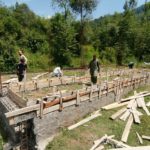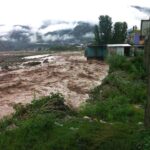Three years on Kashmir Earthquake still haunts survivors.
Zafar Sharif, Chief Co-ordinator of KRDF remembers ahead of the third anniversary of the Kashmir earthquake.
The devastating natural disaster on 8th October left devastating memories on our minds, which has not and will not be forgotten by the people who experienced the earthquake in 2005. I was just about getting up when it started jolting my bed and then the whole house was moving like a small boat in very rough waters. I will never forget this experience of then getting up and taking everyone out of the house. It has left marks on people’s memories who saw helpless people dying, buildings coming down like toys falling and earth breaking and mountains falling apart.
There are thousands of earthquake survivors who are now called earthquake refugees and have been living in makeshift tents since the 7.6 magnitude earthquake devastated their villages in the hills three years ago. They’d really like to return to their homes but without land or a house to go to, their families have no choice but to stay in the makeshift camps. Many of them have lost every thing including all members of their families. The promised amount of money by the government has not reached, or if reached not enough to rebuild their shattered homes. The amounts paid, have not even been enough to have the structures of the house built let alone having a one or two bed house.
While many who sought refuge in camps in the quake-affected regions after the disaster, have headed back to their villages to start rebuilding their homes. But for those whose land also crumbled and slid away can’t even think about reconstruction until they have a safe plot. The memories of their loved one who died helplessly haunts them even more.
The earthquake of 2005, which killed over 80,000, injured more than 300,000 people and left more than 3 million homeless in Kashmir and northern Pakistan, was the country’s worst natural disaster. The government promised the reconstruction of homes, public buildings and roads to be finished in five years. But there seems very little of that happening even after three years and makes these people wonder when and how this will happen. Less than 10% of the schools have been built and that is mainly by the NGOs. The Government authority has not been able to do any.
The education centres and health centres were wiped out and children, old age and women are still facing serious health problems in tents and make shift camps.
Volunteers and NGOs are still working to help and relieve the difficulties by providing financial help, shelter, schools and health centres including health visitors. They are making home visits and explaining about ante- and post-natal care, safe drinking water, latrines, waste management, vaccinations and a range of diseases, including diarrhoea and scabies.
KRDF has been concentrating on providing shelter, setting up schools and vocational training centres. The first project was to try and rebuild a primary school in Rawlakot, which was completed with the help of Multi Faith Luton Council group in 2006. The organisation has completed 3 more primary schools, one in Bagh and one in Muzaffarabad and one in Pattika in 2007 and 2008 as well as setting up 11 vocational training centres for women to provide training and opportunity for jobs.







